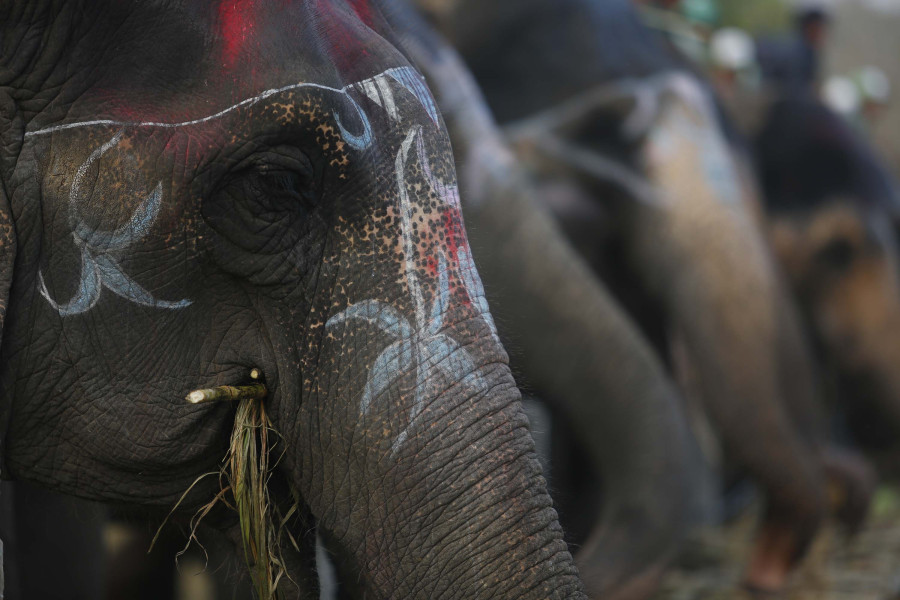National
Nepal’s elephant population trapped between human settlements and mega development projects
As the country's development aspirations grow bigger, its wild elephants are losing their habitats, conservationists have warned.
Chandan Kumar Mandal
Ever-expanding human settlements, deforestation and development projects are undermining Nepal’s elephant conservation efforts, wildlife conservationists have warned.
Speaking during a virtual interaction organised on the occasion of World Elephant Day on Wednesday, the participating experts suggested that the country needs to strike a fine balance between conservation and development to save valuable wildlife species like elephants, which are under threat due to human activities.
“Nepal does not have a large elephant population, but they are facing threats due to human-wildlife conflict and habitat encroachment,” said Dinesh Neupane, who has been studying elephants for more than a decade now. “Many mega development projects either traverse through their habitats or are being built along their core habitat areas, which are already narrow. There is a risk of these projects further deteriorating the core elephant habitats and hindering the animal’s movement.”
Nepal’s wild elephant population ranges between 150-200. The country also welcomes around 200 migratory elephants every year. These populations roam around mainly in four sub-populations—eastern, central, western and far-western.
However, the four sub-populations, also described by Elephant Conservation Action Plan (2008-2018), have come down to two in recent years, says Narendra Man Babu Pradhan, an elephant ecologist and the programme coordinator with IUCN Nepal.
“Problem arises after 1950 with malaria eradication programmes and new settlements in the Tarai where people did not only migrate from the Hills, but also Burma and northeast India,” said Pradhan, who had also served in a government position in the conservation sector. “They stripped down the forest areas and settled down in the low-lying Tarai plains, which used to be elephant habitats and corridors. Earlier, there used to be one long chain of elephant movement from Assam to northwest India via Nepal. This path was cut off due to massive deforestation.”
Now wildlife conservationists worry that the mega projects like East-west railway, Tarai expressway, proposed Nijgadh airport, Postal Highway and upgradation of East-West Highway will further damage what little remains of the elephant habitats and their corridors. Elephant habitats are already under threat due to deforestation, urbanisation and various human activities.
According to Pradhan, restricted movement of elephants has become a major cause behind increasing elephant-human conflicts in recent years.
“In the last 15 years, 197 human deaths have been attributed to conflicts with elephants. There are also retaliation killings of elephants as more than 21 elephants were killed in the same period,” said Pradhan. “Forest corridors are vital for elephant movement along India and Nepal. But such corridors are facing uncertainty due to human activities. Ongoing deforestation and infrastructure development are major threats to the elephant population at the moment.”
Conservationists are concerned that the upgradation of East-West Highway into four lanes and the Postal Highway Project could hinder their movement of elephants along several corridors.
Meanwhile, Sikta Irrigation Project and Rani Jamara Irrigation Project have already disrupted the movements of elephants inside Banke National Park and Karnali Corridor, said Pradhan.
“We don’t know what East-West Railway would do to the movements of elephants, but cases from India and Sri Lanka suggest that there is a high risk of elephants colliding with moving trains,” said Pradhan. “We also need to worry about the Tarai expressway, which will bisect Parsa National Park, and the proposed Nijgadh airport.”
At the interaction organised by the Resources Himalaya and Environmental Graduates in Himalaya to discuss human-elephant harmony in country’s development context, the participants also raised concerns about the number of development projects based around the foothill of Chure range or low-lying Tarai districts—the habitat of native and migratory elephants.
“There will be an impact on the development process on the quality of the environment. Environmental pollution, wildlife habitat destruction are the externalities of development,” said Dadhi Adhikari, director of South Asian Institute for Policy Analysis and Leadership, a think tank. “Nepal needs development and economic prosperity as well. The lack of infrastructure is the major factor behind the country falling behind in development.”
Adhikari highlighted that as the country's infrastructure is in poor conditions, it cannot imagine the development and growth of the country without building its infrastructure.
“We need more highways, airports and railways,” said Adhikari. “We need to have a balance between development and environmental quality.”
Construction of Nijgadh airport has long been at the centre of controversy, for it requires massive felling of trees, which conservationists say will spell ecological disaster and disturb a key corridor for elephants, tigers and other wildlife species. Economists, on the other hand, have been saying the airport could be a game-changer project for the country.
“Most of these development projects are concentrated in the Tarai because it is geographically viable but the area also has dense forest, causing conflict,” said Adhikari. “We cannot say we don’t need Nijgadh airport but cutting down nearly 2.5 million trees is also a serious issue at the same time. We need more analysis on what if, for instance, construction of Tarai expressway reduces the environmental burden of the already stressed Kathmandu Valley. Also, what is the guarantee that by not developing Nijgadh airport we will see a rise in elephant population in that particular area?”
According to Hari Bhadra Acharya, an ecologist with the Department of National Park and Wildlife Conservation, elephant habitats and corridors have been fragmented with the construction of settlements and roads.
“They can travel as far as 800-km and often follow their traditional routes. But with construction and human settlements, their movement is disturbed,” Acharya told the Post. “Disturbance to their old routes means interaction with the public, only increasing the risk of more human conflict incidents with loss of lives and properties. Despite the low number of elephants, human-wildlife conflicts are high for elephants and leopards.”
Beside habitat fragmentation, elephants are still prone to poaching and elephants have died after being electrocuted and other reasons at alarming rates as said by conservationists when compared to other countries with large elephant populations.
Sociologist Anita Shrestha said all development activities should be conducted by keeping wildlife and humans at the centre so that they do not cause harm to each other.
Pradhan, the elephant ecologist, reiterated the need to protect elephant habitats and corridors.
“Elephants need to travel as they are nomads. They take their traditional routes,” he said. “Any disturbance will affect their population demography. We may not expand the areas and their population drastically, but we have to maintain the existing population.”




 12.12°C Kathmandu
12.12°C Kathmandu















